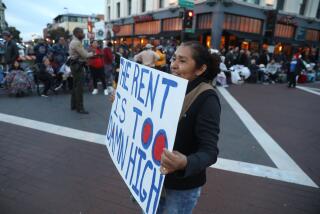Occupy Wall Street shifts from protest to policy phase
How do you know when a protest movement is starting to scare the pants off the establishment?
One clue is when the protesters are casually dismissed as hippies or rabble, or their principles redefined as class envy or as (that all-purpose insult) “un-American.”
Nothing shows that as powerfully as the reaction to the Occupy Wall Street protests that have spread from the financial district in lower Manhattan to cities nationwide, including Los Angeles. Conservative politicians have condemned the Occupy Wall Street protesters as “mobs” supporting the “pitting of Americans against Americans” (Rep. Eric Cantor, R-Va.) and proponents of “class warfare” (GOP Presidential hopeful Herman Cain, who also hung on them the “anti-American” label).
On the other side of the aisle, Democrats are expressing support, if gingerly thus far, for the anger against the financial industry underlying the new protests: “People are frustrated, and the protesters are giving voice to a more broad-based frustration about how our financial system works” (President Obama) or “I support the message to the establishment…that change has to happen” (House Minority Leader Nancy Pelosi, D-San Francisco).
Progressives plainly hope that Occupy Wall Street will help give concrete form to a political narrative that so far has remained abstract in the public mind: That the financial industry has so far gotten a pass on its responsibility for the 2008 crash and escaped sufficiently stringent regulation, while government assistance to banks and Wall Street firms has left consumers in the dust.
But moving from protest to policy is the hardest leap that grass-roots organizations face, akin to turning a promising patent into a billion-dollar business. Occupy Wall Street is just now entering that very difficult, and very interesting, phase.
The principal rap against the protests is that they’re inchoate — both in their ends (Are they articulating much more than an undifferentiated rage at banks and wealth?) and their organization (Are they more than idle hippies camping out in a downtown park?). Yet both points are erroneous.
For one thing, the concerns of the protesters are considerably more focused than their critics acknowledge. They involve the extreme inequality of wealth and income that has hobbled the U.S. economy over the last few decades, the imbalance between the government assistance given big banking institutions and that offered the homeowners who are their customers, and the failure to implement meaningful reform on elaborate financial strategies and instruments.
That the latter contributed overwhelmingly to the crash of 2008 is no secret. Jamie Dimon, chairman and CEO of JPMorgan Chase, acknowledged as much in his 2010 annual letter to shareholders. In it he listed six causes of the crisis, the first four of which were a lack of liquidity in money market funds and the rest of the short-term financial markets; high leverage (that is, excessive borrowing) “omnipresent” in the financial system; poor mortgage underwriting; and unregulated “shadow banking” (off-the-books investing and trading).
Those were not conditions that just happened to the banks, as though deposited by a meteor shower. They were created by the banks, including Dimon’s, in an effort to exploit flaws and gaps in government regulations in quest of short-term profits. And the banks have been front and center in campaigns to dilute regulations proposed to address almost all of them.
Implicit in the protests is the idea that the banks have resumed their old practices with barely a hiccup, while pleading that the modest regulatory changes that have been passed have somehow hobbled their ability to do business. How do we know this plaint is a sham? One only has to look at the handsome resurgence of profits in the financial industry since 2008. According to the government’s bureau of economic analysis, those profits reached an annualized $438.9 billion in the second quarter this year, up from $122.2 billion in calendar 2008.
More telling, they accounted for nearly 32% of all U.S. corporate profits in the second quarter, up from 13.4% in 2008. That’s important, because it documents an unhealthy domination of economic activity in the U.S. by financial transactions, many of which, as we’ve come to learn, contribute little to economic productivity. That ratio is not only too high, incidentally, it’s way out of line with the historical norm, which is closer to the range of 8% to 12%.
Meanwhile, the income disparity between the top earners and everyone else has soared. According to the Congressional Budget Office, in 1980 the share of all pre-tax income collected by the top 1% of earners was 9.1%; in 2006 it was 18.8% (federal taxation cut that share to 16.3%). In 1980, the average income of the top 1% was about 30 times that of the lowest 20% of households; in 2006 it was more than 100 times that of the lowest quintile.
These are the conditions and numbers that inspire the Wall Street protests. On a march through lower Manhattan staged last week by Occupy Wall Street, two placards were most commonly seen, says Todd Gitlin, a Columbia University expert in social movements and a former student activist who accompanied the march: “We are the 99%” and “The banks got bailed out, we got sold out.”
As for planning, Occupy Wall Street has reached a delicate stage at which what may have been born as a ragtag protest is being infused with professionals from groups with organizational skills such as Moveon.org and labor unions. Those groups helped plan the attention-grabbing march Thursday, but the change may produce internal dissension over the participants’ conflicting agendas.
Yet grass-roots movements rarely achieve much until they’re yoked to movements with specific goals and the wherewithal to achieve them. After all, Rosa Parks was not just another seamstress angered by racial segregation on the bus system in her hometown of Montgomery, Ala.; she was the secretary of the local National Assn. for the Advancement of Colored People chapter. Her refusal to give up her seat to a white passenger one day in 1955 was a spontaneous act of civil disobedience, but it wasn’t lost on civil rights leaders that her standing in the community, the stability of her home life and her personal dignity made her the ideal symbol of an organized bus boycott and a test case challenging segregation in court.
No one can know today whether this new protest has legs. (“It’s somewhere between a moment and a movement,” Gitlin says.) History warns, however, that it’s unwise to dismiss it as merely the work of a rabble. In 1932, after an Army detachment under the command of Douglas MacArthur violently broke up a peaceable encampment of the Bonus Army — a movement of World War I veterans agitating for early payment of a promised government bonus to help overcome destitution caused by unemployment — President Herbert Hoover endorsed the bloody confrontation with the words “Thank God we still have a government in Washington that knows how to deal with a mob.”
Listening to radio reports of the violence from his New York home, Franklin Roosevelt turned to his close aide Felix Frankfurter. “Felix,” he said, “this elects me.”
Michael Hiltzik’s column appears Sundays and Wednesdays. His latest book is “The New Deal: A Modern History.” Reach him at mhiltzik@latimes.com, read past columns at latimes.com/hiltzik, check out facebook.com/hiltzik and follow @latimeshiltzik on Twitter.







